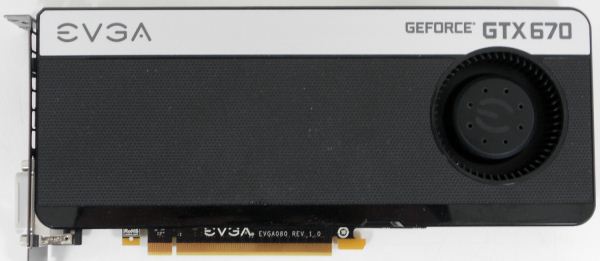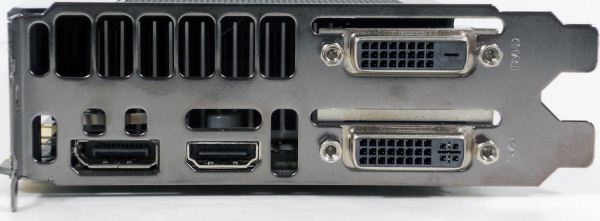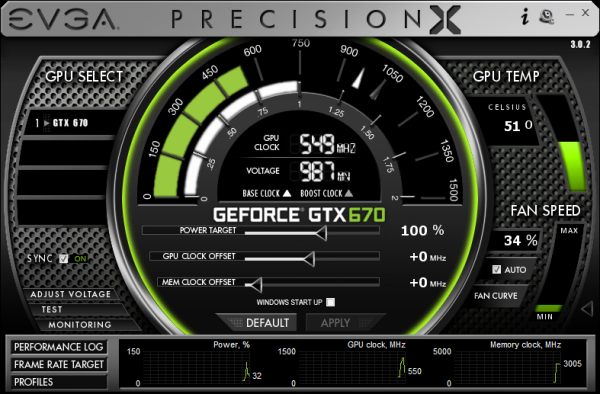NVIDIA GeForce GTX 670 Review Feat. EVGA: Bringing GK104 Down To $400
by Ryan Smith on May 10, 2012 9:00 AM ESTMeet The EVGA GeForce GTX 670 Superclocked
Our second card of the day is EVGA’s GeForce GTX 670 Superclocked, which in EVGA’s hierarchy is their first tier of factory overclocked cards. EVGA is binning GTX 670s and in turn promoting some of them to this tier, which means the GTX 670 Superclocked are equipped with generally better performing chips than the average reference card.
| GeForce GTX 670 Partner Card Specification Comparison | ||||
| EVGA GeForce GTX 670 Superclocked | GeForce GTX 670 (Ref) | |||
| CUDA Cores | 1344 | 1344 | ||
| Texture Units | 112 | 112 | ||
| ROPs | 32 | 32 | ||
| Base Clock | 967MHz | 915MHz | ||
| Boost Clock | 1046MHz | 980MHz | ||
| Memory Clock | 6210MHz | 6008MHz | ||
| Memory Bus Width | 256-bit | 256-bit | ||
| Frame Buffer | 2GB | 2GB | ||
| TDP | 170W | 170W | ||
| Manufacturing Process | TSMC 28nm | TSMC 28nm | ||
| Width | Double Slot | Double Slot | ||
| Length | 9.5" | 9.5" | ||
| Warranty | 3 Years | N/A | ||
| Price Point | $419 | $399 | ||
For the GTX 670 SC, EVGA has given both the core clock and memory clock a moderate boost. The core clock has been increased by 52MHz (6%) to 967MHz base and 66MHz (7%) boost to 1046MHz. Meanwhile the memory clock has been increased by 202MHz (3%) to 6210MHz.
Other than the clockspeed changes, the GTX 670 SC is an almost-reference card utilizing a reference PCB with a slightly modified cooler. EVGA is fabricating their own shroud, but they’ve copied NVIDIA’s reference shroud down to almost the last detail. The only functional difference is that the diameter of the fan intake is about 5mm less, otherwise the only difference is that EVGA has detailed it differently than NVIDIA and used some rounded corners in place of square corners.
The only other change you’ll notice is that EVGA is using their own high flow bracket in place of NVIDIA’s bracket. The high flow bracket cuts away as much metal as possible, maximizing the area of the vents. Though based on our power and temperature readings, this doesn’t seem to have notably impacted the GTX 670 SC.
While we’re on the matter of customized cards and factory overclocks, it’s worth reiterating NVIDIA’s position on factory overclocked cards. Reference and semi-custom cards (that is, cards using the reference PCB) must adhere to NVIDIA’s power target limits. For GTX 670 this is a 141W power target, with a maximum power target of 122% (170W). Fully custom cards with better power delivery circuitry can go higher, but not semi-custom cards. As a result the flexibility in building semi-custom cards comes down to binning. EVGA can bin better chips and use them in cards such as the Superclocked – such as our sample which can go 17 boost bins over the base clock versus 13 bins for our reference GTX 670 – but at the end of the day for stock performance they’re at the mercy of what can be accomplished within 141W/170W.
In any case, as the card is otherwise a reference GTX 670 EVGA is relying on the combination of their factory overclock, their toolset, and their strong reputation for support to carry the card. EVGA has priced the card at $419, $20 over the GTX 670 MSRP, in-line with other factory overclocked cards.
On the subject of pricing and warranties, since this is the first EVGA card we’ve reviewed since April 1st, this is a good time to go over the recent warranty changes EVGA has made.
Starting April 1st, EVGA has implemented what they’re calling their new Global Warranty Policy. Starting July 1st, 2011 (the policy is being backdated), all new EVGA cards ship with at least a 3 year warranty. And for the GTX 600 series specifically, so far EVGA has only offered models with a 3 year warranty in North America, which simplifies their product lineup.
To complement the 3 year warranty and replace the lack of longer term warranties, EVGA is now directly selling 2 and 7 year warranty extensions, for a total of 5 and 10 years respectively. So instead of buying a card with a 3 year warranty or a longer warranty, you’ll simply buy the 3 year card and then buy a warranty extension to go with it. However the extended warranty requires that the card be registered and the warranty purchased within 30 days.
The second change is that the base 3 year warranty no longer requires product registration. EVGA has other ways to entice buyers into registering, but they’ll now honor all applicable cards for 3 years regardless of the registration status. At the same time the base 3 year warranty is now a per-product warranty (e.g. a transferable warranty) rather than per-user warranty, so the base warranty will transfer to 2nd hand buyers. The extended warranties however will not.
The third change is how EVGA is actually going to handle the warranty process. First and foremost, EVGA is now allowing cards to be sent to the nearest EVGA RMA office rather than the office for the region the card was purchased from. For example a buyer moving from Europe to North America can send the card to EVGA’s North American offices rather than sending it overseas.
Finally, EVGA is now doing free cross shipping, alongside their existing Advanced RMA program. EVGA will now cross-ship replacement cards for free to buyers. The buyer meanwhile is responsible for paying to ship the faulty card back and putting up collateral on the new card until EVGA receives the old card.
There’s also one quick change to the step-up program that will impact some customers. With the move to purchasing extended warranties, the step-up program is only available to customers who either purchase an extended warranty or purchase an older generation card that comes with a lifetime warranty. Step-up is not available to cards with only the base 3 year warranty.
Moving on, along with EVGA’s new warranty EVGA is bundling the latest version of their GPU utilities, Precision X and OC Scanner X.
Precision X, as we touched upon quickly in our GTX 680 review, is the latest iteration of EVGA’s Precision overclocking & monitoring utility. It’s still based on RivaTuner and along with adding support for the GTX 600 series features (power targets, framerate caps, etc), it also introduces a new UI. Functionality wise it’s still at the top of the pack along with the similarly RivaTuner powered MSI Afterburner. Personally I’m not a fan of the new UI – circular UIs and sliders aren’t particularly easy to read – but it gets the job done.
OC Scanner X has also received a facelift and functionality upgrade of its own. Along with its basic FurMark-ish stress testing and error checking, it now also offers a basic CPU stress test and GPU benchmark.



















414 Comments
View All Comments
B-Unit1701 - Saturday, May 12, 2012 - link
So we now price GPUs on an arbitrary 'tier' ranking instead of based on performance? Awesome.CeriseCogburn - Sunday, May 13, 2012 - link
The tier ranking is based upon performance, with the solidness of many months of pricing solidifying those tier placements.Way to go fella, being that stupid shouldn't be a hobby or a habit.
euler007 - Thursday, May 10, 2012 - link
I've been waiting for the 680 to come in stock for weeks.It's pretty sad when you need to snipe newegg and the manufacturer's stores (or pay 10% markups on amazon stores) to buy a product.
Morg. - Thursday, May 10, 2012 - link
The 680 is a lie, it'll reach production quantities in 3 months maybe ;)CeriseCogburn - Friday, May 11, 2012 - link
Just the EVGA 680 has sold more than the 7850 and 7870 combined at newegg.So despite 680 supply constraint, it is doing better than amd's entire 78xx lineup there.
ROFL - now that's sadness for amd fans
SlyNine - Saturday, May 12, 2012 - link
You're basing this on verified buyers on neweggs reviewed cards. Logic doesn't get much more flawed then that.CeriseCogburn - Sunday, May 13, 2012 - link
Logic doesn't get much better than that, nor does accuracy - it's worked for years now, just because you are absolutely clueless does not make it invalid.Crazyeyeskillah - Thursday, May 10, 2012 - link
if you can't afford it, it's your own fault. Every time I see a classless arrogant self entitled poster complaining about the pricing of all these new generations it makes me sick. There is a card in your price range, whatever your budget is. Just because they make expensive hardware doesn't mean it's for you, so why are you screaming about it constantly? I'm not screaming that I can't afford a 7 series BMW so don't embarass yourself. It makes you look foolish at best. People will agree with you because they are also in the throngs of life's underachievers who think they are entitled to a lifestyle they haven't worked for. If you really want it, save for it. I'm happy to pay for an ultra premium product that delivers an experience that I can say is truly enjoyable.THEY NEED TO LOWER THE PRICE OF f-35's NOW CRY CRY
cek
chizow - Thursday, May 10, 2012 - link
So if you bought a BMW 7 series for the last 15 years, and then BMW tried selling you a 3 series labeled and priced as a 7 series, you'd just buy it at 7 prices no questions asked and be satisfied?If so, you'd certainly be entitled to everything born of ignorance.
RussianSensation - Thursday, May 10, 2012 - link
It's hilarious how people still keep using this argument: "If you can't afford it, don't complain about price." Many of us can afford the card. The main discussion at hand is that NV released a mid-range/upper mid-range line-up of chips that's a replacement for GTX560Ti and priced them at $400-500. Can you imagine if this was happening since GeForce 2 days, how much slower would the current cards be?Even the reviewer noted that this is the least performance improvement from a new architecture + full node shrink in the history of NV. GTX670/680 are still good cards, but it doesn't change the fact that they aren't true flagship replacements for GTX480/580. Otherwise, AMD/NV will just launch 25-30% faster new generations every 18 months and we are supposed to eat it up for $500? Hopefully HD8000 and GTX780 will remedy the situation :)